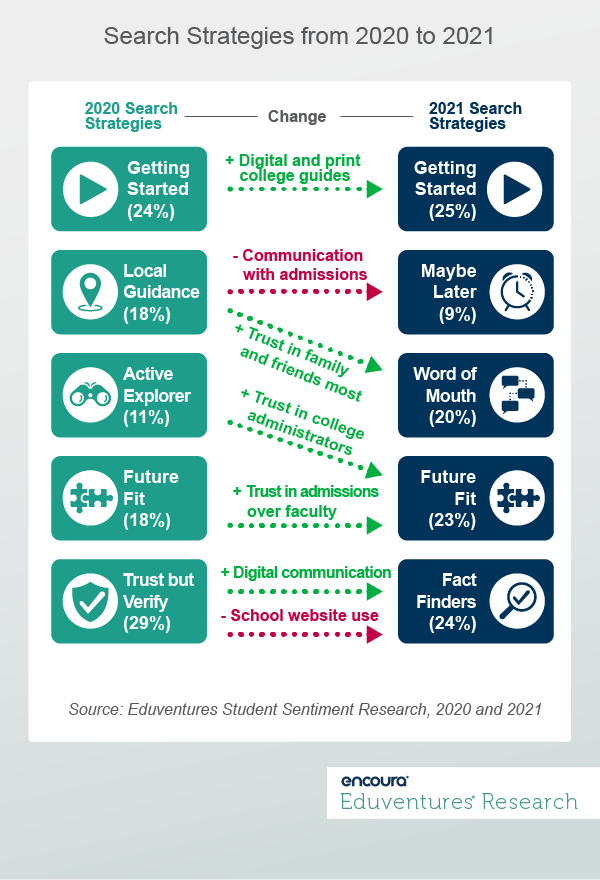Last year, just as many colleges across the country were announcing remote fall schedules, we unveiled Eduventures Search Strategies—five distinct approaches that college-bound high school students take when approaching college search. This year, remote vs. on-campus policies have been eclipsed by those around masking and vaccination requirements. Fall travel is starting back up, although it may look different than before. The recruitment environment has shifted once again, and so has the prospective student experience.
Given these shifts, it may not come as a surprise that
What are Search Strategies?
The Eduventures annual Student Sentiment Research explores the college search behavior and communication preferences of college-bound high school students. As part of our 2021 analysis, we identified five distinct approaches – or Search Strategies – in which students conduct their college searches. These Search Strategies are based on the college information sources that students trust most and their preferred ways to communicate with admissions offices.
These five Search Strategies are:
Getting Started (25%)
Students who use this strategy, many of whom are early in search, check out the basics like email, print, and website, but also like to consult online and print college guides.
Fact Finders (24%)
Students who use this strategy prefer digital communication with admissions, but mostly trust information from third parties like rankings, online college guides, and current students and alumni.
Maybe Later (9%)
Students who use this strategy, many of whom are early in search, are the least active. They may browse a college website, talk to their high school teachers, or read the occasional email from admissions.
Word of Mouth (20%)
Students who use this strategy rely predominantly on insights from their—often college educated—families and friends as well as current students and alumni. They like to text with admissions offices.
Future Fit (23%)
Students who use this strategy are eager to communicate with admissions—especially via text and over the phone—whom they trust the most for information about colleges. They also like to talk with faculty.
How have these Search Strategies shifted?
A comparison between these 2021 Search Strategies and those observed last year shows signs of stability in student approaches to college search, but also key changes—in particular, the emergence of two new segments. Changes we observed include:
Getting Started: Students who use this strategy indicated a greater reliance on both digital and print college guides as trusted resources this year.
Maybe Later: Mapping most closely to the “Local Guidance” strategy from 2020, these students may talk to those in their high school orbits and browse school websites, but they would rather not communicate directly with admissions aside from the occasional email.
Word of Mouth: Unlike students who used the “Local Guidance” strategy from 2020, these students trust family and friends more for information about colleges above that of high school counselors and teachers.
Fact Finders: Students who use this strategy, which evolved from 2020’s “Trust but Verify,” are now showing less trust in institutional stories compared to their peers a year ago. They also show a greater preference for communicating with admissions digitally—through social media and live chat.
Future Fit: The students who use this strategy focus less on communicating with faculty and show greater engagement with admissions compared to last year.
Figure 1 provides an overview of these shifts from 2020 to 2021.

In summary, we see some student segments rely more than before on third-party information like college guides and rankings (Getting Started and Fact Finders) or family and friends (Word of Mouth). This may indicate a greater desire to find information from trusted, third-party sources in a confusing and uncertain search environment. Another student segment (Future Fit), on the other hand, shows greater affinity for information directly from admissions offices – many of which have worked incredibly hard to engage prospects over the past year.
Across most Search Strategies this year, we also noticed a greater preference for digital communication with the admissions offices. Students seem to have embraced text messaging, live chat, and even social media interactions with admissions over the past year. The one exception is the Maybe Later strategy who is less interested in interacting with the admissions office in general.
How can I use these Search Strategies?
What do the 2021 Search Strategies—and their consistencies and changes from 2020—mean for your recruitment efforts this fall? While we remain very much in a pandemic recruitment environment? We have one more year of experience under our belts—as do students who have made some adjustments in their approaches to College Search.
While many admissions offices prepare to send staff back on the road, we predict that personalized outreach will become even more important than ever before, digital communication is here to stay, and the need for community engagement will only grow.
We also recommend taking the following steps to future-proof your recruitment outreach:
- Review your channel outreach strategy to see how you can increase or improve social media, texting, live chat, and other digital communication with your key audience segments.
- Continue personal and personalized outreach. Instead of traditional high school visits, consider one-on-one meetings with interested students and their families.
- The increase in third-party information points toward a desire for an unbiased opinion. You can strengthen trust in your institutional narrative by bringing in more stakeholder voices from current students, alumni, and faculty.
For more information about the Search Strategies and student search behaviors and preferences, please reach out to your Client Research Analyst or visit Encoura Data Lab for the new Student Sentiment Research tool.
Never Miss Your Wake-Up Call
Learn more about our team of expert research analysts here.
Eduventures Senior Analyst at Encoura
Contact
Over the past three years, Eduventures has developed a behaviorally and attitudinally-based market segmentation of college-bound high school students we call Student Mindsets™. This year, the sample of nearly 40,000 respondents was drawn from the myOptions® database of college-bound high school juniors and seniors as well as institutional inquiry lists, allowing us to refine and validate the Mindsets in a national sample of unprecedented breadth and depth.
These market “Mindsets” get at students’ imagined paths through college by assessing the desired outcomes of college, perceived importance of college experiences, and key decision criteria at time of application.
The fundamental purpose of the Eduventures Prospective Student Research is to help institutions better understand how college-bound high school students approach one of the most important decisions of their young lives. For a teenager, the college decision looms as a complex make-or-break moment, a pivotal turn on an imagined path to adulthood.
Thursday September 16, 2021 at 2PM ET/1PM CT
Enrollment offices have always known to evolve with the changing tides of the market. Old models utilizing zip code targeting and “boots on the ground” support leave great fit students underrecruited. Today’s landscape requires, and students deserve, a more strategic approach. With the normalization of advanced machine learning and exploratory analytics, enrollment leaders can now identify new opportunities and more effectively target their efforts.
In this webinar, Senior Vice President Clint Chapman and Vice President Bethany Moran will share enhanced solutions for enrollment teams aiming to strategically use their budgets and time and invest in the students that are most likely to enroll in their institutions. Join us as they reveal practical ways you can optimize your data using effective targeting, analytics, and technology so that you make your next class.






